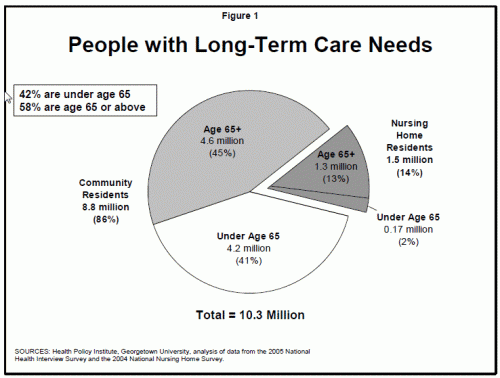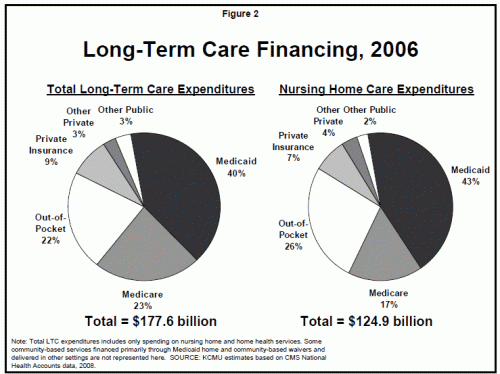Long term care (LTC) is help and support to enable persons to deal with disability. Most think of nursing homes (NH) when they hear the phrase LTC, but only 1.6 Million persons live in a NH (see figure 1 below); the vast majority needing LTC live in community settings. Larger estimates of LTC are found when using a more expansive definition; AARP estimates that there are 30-38 Million persons (mostly family members) providing LTC to someone. The uncertainty in how many persons need and receive LTC underscores the fact that most do not live in institutions, making them difficult to count.
There are many inter-related ways to characterize LTC, all of which are important to understand what role CLASS could have played, and more importantly, to identify what needs to be done.
- Disability progression. When disability onsets for the elderly, most persons initially need help in completing Instrumental Activities of Daily Living (IADL) such as shopping, paying bills, navigating health care visits, and cooking meals. Some have more severe limitations in Basic Activities of Daily Living (BADL), such as eating, bathing, dressing and using the toilet. A NH is best understood as a 24/7 provider of both BADL and IADL care. Disability progression can be more diverse in younger populations, some of whom need complete care due to a catastrophic event, and may need it for years or even decades.
- Informal Care. Informal simply means unpaid, and most of this care is provided by family members, with spouses (87% of caregivers) being by far the most common provider followed by adult children. AARP has estimated that the cost of caregiving to be $350 Billion annually (based on their estimate of 30-38 Million informal caregivers), or more than twice the total cost of NH care.
- Formal Care. Formal care is paid care, regardless of whether an individual or an insurer pays. The Kaiser Family Foundation (fig 2) shows the major reliance on out of pocket payment and Medicaid to finance formal LTC generally, and especially for care in a NH. Keep in mind that the figures below does not account for informal care, valued at $350 billion annually.
This was the default into which CLASS was supposed to enter, and which we have today. What role would CLASS have played in LTC?
- CLASS benefits could be used for any LTC service, but were small ($50-$75/day), far less than the cost of a NH (several times that).
- Benefits were best understood as either replacing some informal care hours and/or adding specialized, paid help for persons living with disability in the community.
- It is possible that CLASS benefits could have delayed entry to a NH, allowing persons to remain in community settings longer.
- CLASS would provide these low level benefits for an unlimited period; by contrast, private LTC insurance (which is rare) typically provides NH level benefits for a short period of time (1-3 years typically). Medicaid pays for NH care once eligible until death.
The goal of CLASS was to make planning for LTC a normal part of adulthood. Most persons do not plan at all, sometimes because they do not understand that Medicare pays for only limited amounts of LTC (home health), causing persons to rely on informal caregiving and defaulting into Medicaid to pay for the most expensive setting of care if they are impoverished (often due to paying LTC costs). CLASS wouldn’t have ended all of the LTC financing problems even if it was fully successful, but it would have contributed, and it would have been an example of forward looking policy in LTC. If the demise of CLASS is simply a political scalp it will be a missed opportunity to have a full discussion about how we will insure LTC.



